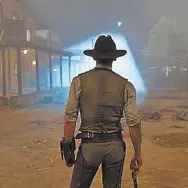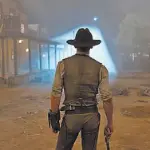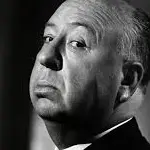This year’s Palme d’Or winner is a film by French director Justine Triet. Ascending to such heights might not always be a wholly fortunate occurrence. This reality amplifies the stereotypical expectations associated with the film "Anatomy of a Fall," given its overt criminal undertones. The film revolves around the lives of a German female writer, Sandra, and a French male writer and teacher, Samuel, along with their son and their beloved dog, as they move into a remote house in the suburbs. Unexpectedly, Samuel plunges to his death in broad daylight, triggering a trial that lays bare their concealed lives in the courtroom.
An Anatomy of a Death by a Fall?
The “Fall” is a moment, while the "Anatomy" is a process. The former is an event, the latter aims to discover its causes. After briefly introducing the characters and the setting, the film quickly depicts Samuel's fall and sudden death. This abrupt death leaves the audience with no time to fully grasp the character who has suddenly vanished, and we can only catch glimpses of his persona through the various accounts of others. The deceased is both present and absent in the film. Following this introduction, the film's title emerges, signaling the official beginning, and we are led into a protracted exploration of the intricacies of the story.
The extended questioning and courtroom drama could be a heavy blow to the film's appeal. However, the cause of death remains shrouded in mystery, guiding the audience through diverse narratives from different individuals. Viewers witness the defence attorney skilfully confining the facts, reproductions, and speculations within the existing legal boundaries, intensifying the intrigue surrounding the case. This is the dramatic convention of legal/courtroom films.

However, the film's brilliance does not lie in the conventional dramatic conflicts and narrative tension of courtroom dramas; it does not aim to create pleasure in piecing together complex stories too. Instead, it follows a lineage in film history initiated by "Witness for the Prosecution": how a plot twist expresses the intention.
If films like "Philadelphia" is about how circumstances weighing triumphs over the law, then "Anatomy of a Fall" is about how a "simple" death invades the "complex" lives of ordinary people, how it violently creates a clear narrative in the midst of an unclear daily life, and how it draws definitive conclusions about the recently deceased.

The lengthy analysis may seem excessive and unappealing, but by infusing it with dramatic elements, the film transforms the tension of being on the brink of judgment and the sense of helplessness into an enjoyable viewing experience.
How is “Watching” Being Ignored?
The act is performed, observed, and the act of watching is a deliberate, summoned process. The deceased's perspective doesn't exist, and the wife, Sandra is judged. Through the eyes of their son Daniel, who is present in the courtroom, we witness the unfolding of the anatomy.
However, the observer's gaze vanishes within the complex narratives of various media. This is a unique media game that belongs to the contemporary era, much like last year's "Decision to Leave", which portrayed an extraordinary love affair and deception achieved through mobile devices, updating the genre of "women deceiving men" in films noir. Similarly, "Anatomy of a Fall" touches on an epistemological crisis within the new media.

The promised "clearer images" and "discernible audio" offered by technology only further complicate the dilemma of perception, rather than leading to an unambiguous reality. Convenient storage behaviours leads to information overload, making it possible to selectively extract meaningful fragments from the vast "vocabulary" and assemble them into the "sentence structure" of a lie: each part is true, but the overall result is fictional. It constructs a lie in the form of "telling no lies." So, watching becomes a form of wilful ignorance. Evidence contradicts the truth it indicates, and lies become the truth.
In the film, Daniel speaks of the need to "construct a real lie" (to prove his mother's innocence). But after witnessing the lengthy trial, he decides to conduct an experiment: he feeds the dog aspirin and confirms that his father did indeed attempt suicide. Later, in Daniel's testimony in court, he "recreates" a conversation he had with his father in the car (about life and death), while the film "recreates" the scene of Samuel in the car. This is a clever and precise juxtaposition of sound and image, confirming Samuel's suicidal tendencies and ultimately leading to declaration of Sandra’s innocence.
The protracted trial comes to an end, a victory for the subjective memory of the son over the various media reproductions, a victory of sentimentality over jurisprudence, and a victory of the "true statement" over the "real lie."
How is Power Reversed?
Focusing back on the relationship of the couple, perhaps this is a typical exploration of intimate relationships in the style of "Marriage Story." Sandra's success in her career and her bisexuality make her the stronger party in the relationship, while Samuel, as the film states, "was negligent in causing his son's visual impairment when he was four years old, leaving him in a sort of castrated state."
Perhaps Samuel's death is due to his frustration with this unbalanced relationship. But embracing such a final judgment would run counter to the film's narrative intentions. The film seems less interested in genuinely analysing the cause of death. The narrative halts at the moment it reveals Samuel's choice to end his own life, implying the conclusion that suicide itself can be viewed as a form of violence.

What we should truly focus on is the gender power dynamics in the context of the film, especially considering that the film is directed by a female director, making her the third female in history to win the Palme d'Or. The film portrays a narrative logic that deviates from mainstream patriarchy. The story unravels the layers of truth and falsehood, exposing the absurdity of legal proceedings in the public realm. The narrative around an individual's life is inherently complex.
How can Narrative be Possible?
From all this, one might arrive at a conclusion: having a narrative is impossible. It is impossible to presenting to the audience the mental state of someone moving towards self-destruction. Yet the director still emphasizes on the necessity of narrative through the narrative itself. "Anatomy of a Fall" can be seen as a culmination of European cinema for the past decade, with mature techniques and an upgrade of such films.

From Mia Hansen-Løve's "Things to Come," "Bergman Island," and "One Fine Morning" to Olivier Assayas ' " Clouds of Sils Maria," to German director Maren Ade's "Toni Erdmann," and to various works by veteran Italian director Nanni Moretti, this kind of "collapse and restoration of an intelligentsia’s life " film in Europe has become highly proficient and winning a Palme d'Or was an inevitable outcome, sooner or later.
Indeed, it is crucial to acknowledge that reflecting on life, death, and suicide is a humanistic tradition in Europe, rooted in existentialist philosophy but extending beyond its boundaries. In films like "Anatomy of a Fall," which delve into themes of life and death, the message conveyed is that the narrative serves as a form of rebirth and a direct confrontation with mortality.
When director Theroux talked about the fantastic quarrel scene between the husband and wife in the film, she said, "When I wrote the script with my co-writer, we didn't agree on this scene. Actually, creating this scene was also a debate between the two of us about its meaning." The creators argue outside the film context, and the characters argue within the story.
Whether it's the husband and wife in "Anatomy of a Fall," or the actors, teachers, and other characters in the mentioned films, they may all be projections of filmmakers, expressing the director's thoughts about creation itself. Samuel's self-destructive path might represent creative exhaustion and a journey towards death, a point where storytelling no longer stands, and storytellers consciously realize the violence within narrative. They must embark on the "remaking of the narrative" to achieve the rebirth of the creator and the narrative. This is the narrative innovation of the "post-MeToo" era.
The film unfolds for nearly two and a half hours without adhering to a single narrative structure. It avoids exclusive focus on exploring intimate relationships, themes of truth and falsehood, creator anxiety, or the triumph of justice over jurisprudence. While these elements are integral to the film's meaning, it also acknowledges that life itself is not constructed around any singular narrative.




































Share your thoughts!
Be the first to start the conversation.